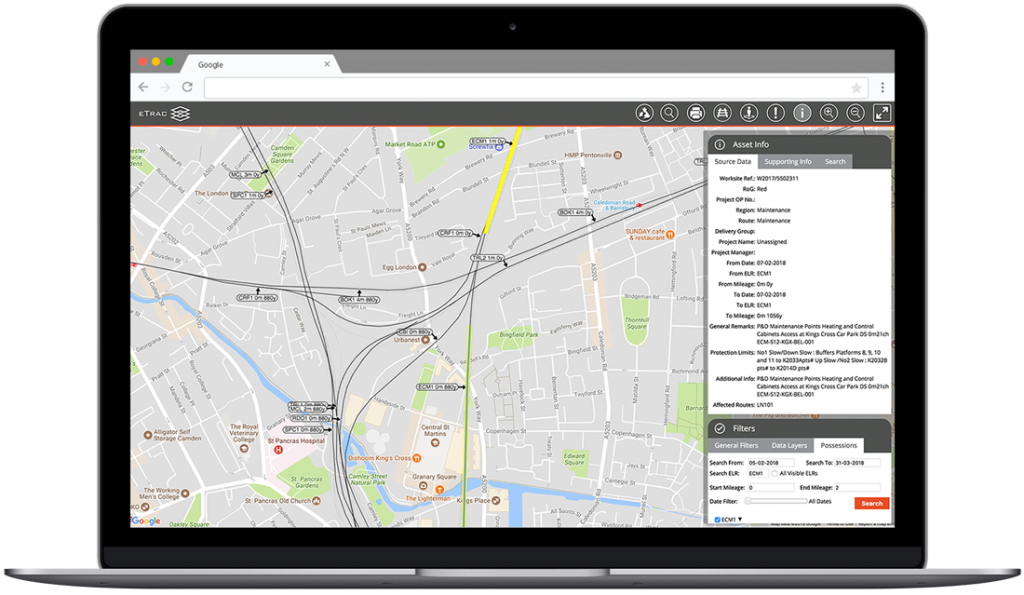In light of this month’s ‘The Rise of IoT and Big Data in Rail’ event, we’re looking at the benefits of harnessing and analysing big data within the sector.
COVID and Industry 4.0 have been the main catalysts for accelerating innovation within the rail industry. With an increased investment on improvements to the sector’s physical infrastructure, its digital infrastructure has quickly moved up in the industry’s priorities.
There have been key indicators of a digital rail revolution over the past decade, with the introduction of personal devices on site, as well as government approved incentives such as Network Rail’s Digital Railway Programme, displaying a shift in mindset within the sector.
Data collection and storage has been commonplace in the industry for quite some time. However, the use of analytics across the railway process has moved on from its infancy and is becoming a fully-fledged facet of everyday operations. This analysis and utilisation of the deluge of data available to the rail industry lies at the heart of both true innovation and future industry success.
Armed with a better idea of how their systems work and the benefits of the technology, users and developers are now looking at ways they can refine, improve and further develop the processes to maximise the benefits of the data within rail.
What is Big Data?
Big data is defined by SAS Insights as extremely large data sets that may be analysed to reveal patterns, trends, and associations. It is a way to deal with data sets that are too large or complex to be dealt with by traditional data-processing application software. This kind of data is typically collected and analysed by businesses, as it can be analysed for insights that lead to better decisions and strategic business moves.
The volume of data naturally gathered by the rail industry can certainly be classified as ‘Big Data’; the amount amassed through planning, reporting and inspections alone is overwhelming. This is why, when using paper-based processes, many rail businesses leave their collected data to gather dust in ring binders, stored away without analysis.
Big data requires analysis through technology, and this is why it’s so important for the rail industry to digitise so it can continually learn and improve its processes.
How can Big Data benefit the rail industry?
While rail companies have previously been interested in gathering as much data as possible, they are now beginning to take a deeper look into what data they specifically need and how to cut through the “noise” to extract meaningful insights that could otherwise be lost. This brings with it multiple benefits to the rail industry, in the form of better planning, predictive maintenance, reduced overheads, and more efficient use of assets to name but a few. Let’s take a closer look at the main areas big data can benefit.

Big Data in predictive maintenance
The use of big data in operations and maintenance addresses a common Achilles’ heel in asset management: prognosis. The accurate estimation of the remaining useful life of an asset is key to the success of any rail organisation.
The rail industry is witnessing a shift in asset management regimes, and efforts are in place to switch from periodic maintenance to condition‑based and predictive maintenance. Predictive maintenance techniques are designed to help determine the condition of in-service equipment in order to predict when maintenance should be performed. This approach promises cost savings over routine or time-based preventive maintenance, because tasks are performed only when warranted. The main agenda of predictive maintenance is to allow for the convenient scheduling of corrective maintenance and to prevent unexpected equipment failures. By knowing which equipment needs maintenance, maintenance work can be better planned.
As well as cost-saving, the predictive maintenance enabled by big data improves safety across a rail workforce. The current reactive and periodic maintenance process means that at times workers are on the railway line and therefore in a high-risk situation on a regular basis.
With predictive maintenance, assets are only being repaired or replaced when necessary, meaning workers don’t need to be on-track as much of the time. According to McKinsey Rail, it’s estimated that condition-based maintenance can reduce manual diagnostics by at least 60%.
Big Data in Asset Planning
Britain is home to over 30,000km of rail track, along which are various different assets and possessions. These assets are prone to be over or under used if there is incorrect planning in place. As there is so much data connected to these assets, it needs to be harnessed and analysed so rail planners can plan works efficiently and reduce overheads.
OnTrac’s data visualisation tool, eTrac-GIS, is already being used by businesses within the rail supply chain to aid project planning and make the most of their assets. Using asset data from multiple sources, such as Ellipse, CARRS, Track Centre Line, OPAS and the National Hazard Directory, eTrac-GIS automatically generates schematics from geospatial data (geomatics) on demand. It can tell you where a possession is on a map, if it is currently being used and how long for. This coupled with predictive maintenance of the possessions and assets means smarter planning all round.
It also means these assets are maintained exactly when they need to be rather than the reactive approach so many rail companies currently take. Rather than waiting for something to go wrong with a possession, which subsequently causes a time-lag in a project, planners can see when depreciation starts and can predict when they will need repairing or replacing. This work can be planned for so there are no surprises and unnecessary delays on a rail project due to failing possessions.

Check out our eTrac-GIS tool here to discover how asset visualisation can benefit your rail works planning
Big Data for passenger experience
Another benefit of big data is improving train service and availability. Many train operators have custom dashboards which feeds from real time data, to support drivers, which is essential for getting the train back into service as soon as possible. The ability to obtain status information and obtain quick train response to queries is vital to keeping trains on time and in turn ensuring the passengers are happy with the service. The data collected can be analysed for trends, component life cycles, or human failure, which means issues can quickly be pinpointed and rectified. This results in the trains reliably running to timetable, more trains can run at once due to effective planning, and there is less chance of breakdowns mid-journey.
An associated benefit for the train operators is the ability to monitor their train driver. This allows them to evaluate whether the train driver is complying with the rules and regulations and whether they need additional training, or even if the rules and regulations need to be updated.
Conclusion
Big Data is progressively being further ingrained into rail industry operations, planning and maintenance, and it’s not difficult to see why. The benefits it can bring to the workers, passengers, and owners alike are undeniable. In the future we can expect real time data and big data to be coined as essential for meeting service based KPIs. We can expect to see less service downtime, better quality planning, and a safer railway by continuing to utilise the power of big data for years to come.


